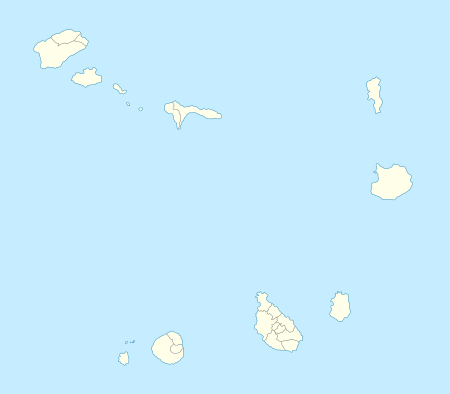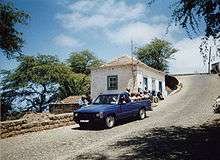Cova Joana
| Cova Joana | |
|---|---|
|
Cova Joana, Main Street | |
 | |
| Coordinates: 14°51′47″N 24°42′47″W / 14.863°N 24.713°WCoordinates: 14°51′47″N 24°42′47″W / 14.863°N 24.713°W | |
| Country | Cape Verde |
| Island | Brava |
| Municipality | Brava |
| Civil parish | Nossa Senhora do Monte |
| Population (2010)[1] | |
| • Total | 183 |
Cova Joana is a village in the central part of the island of Brava, Cape Verde. It is situated in a mountain valley, 2 km southwest of the island capital Nova Sintra.

The name of the village Cova Joana refers to the location, as the creole word cova means crater, depression or valley.[2] The village is linked by a good paved road to Vila Nova Sintra, the capital of Brava which is about seven kilometers away, and to Nossa Senhora do Monte, a pilgrimage place which is about one kilometer to the South. The small harbour Fajã de Água on the West coast can be reached on a beautiful walking track as well as the Monte Fontainhas, the highest mountain of Brava reaching a height of 976 meters.
Brava is known as the greenest island of Cape Verde. Frequently Brava is covered by clouds, so that evaporization is comparatively low and the island can keep its humidity.[3] Humidity is kept even longer in the depression of Cova Joana, where agriculture (especially maize, bananas and beans) is the main source of income. Many houses have a garden where vegetables are grown.
Raúl de Pina, one of the most important musicians of Cape Verde, lived in Cova Joana. He had more than 30 children and he even owned a stradivari.[4] His house is on the right side of the main street and it can be visited after appointment.[5] Raúl de Pina was a friend of Eugénio Tavares (1867-1930), an important writer and composer of Cape Verde who also lived on Brava.
References
- ↑ "2010 Census results". Instituto Nacional de Estatística Cabo Verde (in Portuguese). 17 March 2014.
- ↑ Reitmeier, Pitt: Cabo Verde, p. 416. Bielefeld 2009.
- ↑ Reitmeier, Pitt: Cabo Verde, p. 415. Bielefeld 2009.
- ↑ Osang, Rolf: Kapverdische Inseln, p. 156. Köln 2001.
- ↑ Lipps, Susanne: Kapverdische Inseln, p. 278. Ostfildern 2009.

